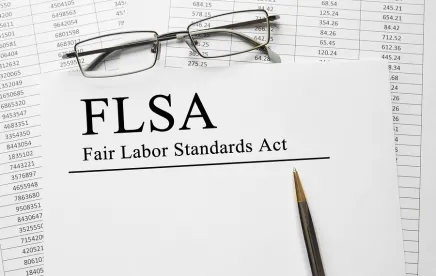Human resources and other professionals who review job positions for possible exemptions under the federal wage and hour law (the Fair Labor Standards Act or FLSA) are familiar with the “salary basis” and “job duties” tests. Employees who work in jobs that meet both tests and who work in true executive, administrative, or professional capacities are exempt from the FLSA’s minimum wage and overtime requirements.
Employers sometimes wonder whether they can pay such salaried exempt employees additional compensation on top of the salary, such as commissions or a percentage of the employer’s sales or profits, without adversely affecting the exemption. The answer is yes, they can. Such additional compensation may be paid on any basis – such as flat sum, bonus payment, straight-time hourly amount, or even time-and-a-half. Employers should make sure, however, that these extra types of payments do not become the primary source of the employees’ pay. Once salary ceases to be the primary source of earnings, employees may be able to successfully claim that they are not being paid properly under the salary basis test.
In addition to being able to receive additional compensation, “white-collar” exempt employees may also be paid on an hourly, daily, or shift basis, without affecting the exemption, as long as certain requirements are met. A recent Opinion Letter from the Department of Labor gives some examples of how employers can make sure they properly pay a weekly guarantee to exempt employees who are paid on an hourly, daily, or shift basis.
The FLSA regulations allow employers to pay on one of these bases as long as:
-
The employment arrangement also includes a guarantee of at least the minimum weekly required amount paid on a salary basis, regardless of the number of hours, days, or shifts worked; and
-
A reasonable relationship exists between the guaranteed amount and the amount actually earned
The regulations also provide that this “reasonable relationship” test is met if the weekly guarantee is roughly equivalent to the employee’s usual earnings at the assigned hourly, daily, or shift rate for the employee’s normal scheduled workweek. Here’s where you get out your calculator.
In the recent Opinion Letter, the employer was paying a guaranteed weekly salary of $2,100 to engineers and senior designers whose job duties met the professional exemption. This amount was calculated by multiplying an hourly rate of $70 by 30 hours, which was the minimum hours the employees typically worked each week. The employees received this amount even if they worked fewer than 30 hours weekly, and when they worked more hours they got an additional $70 for each hour. The employer reviewed its payroll records for these employees for 2017 and determined the employees earned an average of $2,721 per week that year, with average weekly compensation ranging from $1,793 to $3,761.
Directly in the FLSA regulations at issue is an example of an employer paying a guaranteed weekly salary of $500, which the DOL finds to be “reasonably related” to usual earnings of $600 to $750. Because the ratio of $750 per week to $500 per week is 1.5 to 1, the DOL in the Opinion Letter stated that a 1.5 to 1 ratio of actual earnings to guaranteed weekly salary is a “reasonable relationship” under the regulations. If, after you pull out your calculator, you are paying in this range, you should feel good. The DOL itself, and courts that defer to the DOL, will agree that you have satisfied the reasonable relationship test.
The DOL Opinion Letter went on to discuss that the engineers and designers at issue had a usual average salary that was 1.8 times their guaranteed salary. According to the DOL, this ratio, which is close to double the guaranteed weekly salary, would materially exceed the permissible ratios found in the regulations, and therefore such payments would not be roughly equivalent to the weekly guarantee. The DOL stated that while a 1.5 to 1 ratio is not the absolute maximum, employers are wise to take caution if the ratio is much above that range. While 1.8 to 1 clearly exceeds, a best practice would be not to go above, or much above, the 1.5 to 1 ratio in determining a guaranteed weekly salary for paying exempt employees on an hourly, daily, or shift basis.




 />i
/>i
